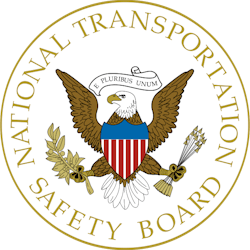NTSB Urges Safety Gear For Taxiing Jetliners
Big jetliners should be equipped with anti-collision equipment such as cameras to help pilots avoid clipping wingtips while taxiing, the National Transportation Safety Board recommended Wednesday.
The recommendation from the safety board to the Federal Aviation Administration follows at least three runway collisions in the past 18 months.
One of the collisions, involving the world's biggest passenger jet, drew national attention: That's when a giant Airbus A380 struck the tail of a small regional jet on April 11, 2011, at New York's John F. Kennedy International Airport.
The problem in larger planes, the NTSB said, is that the pilot can't see the wingtips from the cockpit without opening a window, which the NTSB says is often impractical.
The board suggests that a camera could be mounted with a display in the cockpit so that pilots could see other aircraft and obstacles.
"While collision-warning systems are now common in highway vehicles, it is important for the aviation industry to consider their application in large aircraft," said Deborah Hersman, NTSB chairwoman. Preventing runway collisions has long been a priority for the safety board.
Since 2007, the FAA has added new safety technology, altered procedures for how planes taxi and pressured airlines and airports to make dozens of additional improvements.
In a September 2011 report, the most recent year available, the FAA said the most critical ground errors, called runway incursions, had fallen the previous decade from a high of 67 a year to seven.
Still, incursions occur:
In July 2011, a Delta Boeing 767 was taxiing at Boston's Logan Airport when its left wing struck an Atlantic Southeast Airlines Bombardier CRJ-900. The Bombardier suffered substantial tail damage and the plane lost fluid in three hydraulic systems.
This year on May 30, an American Eagle Embraer 135 regional jet was struck in the tail by the right wing of a Taiwanese EVA Airways Boeing 747, which was taxiing at Chicago's O'Hare Airport. The Embraer suffered substantial damage to the rudder and vertical stabilizer, while the 747 had minor damage to the wingtip and slats.
The NTSB said that new warning equipment should be installed on older planes as well as new ones and that Boeing's 747, 757, 767 and 777 models, along with the Airbus A380 and McDonnell Douglas' MD-10 and MD-11, should be covered.
The airline industry group Airlines for America said the risks are low.
"These types of incidents are extremely rare in the context of overall operations," spokeswoman Victoria Day said. "Airlines have procedures in place using wing walkers and other means to minimize these risks."
Copyright 2012 Gannett Company, Inc.All Rights Reserved

